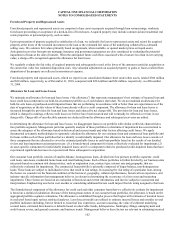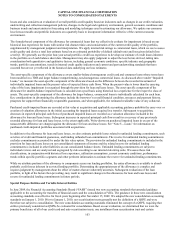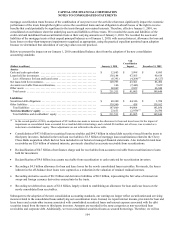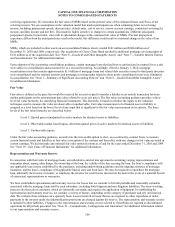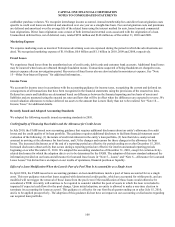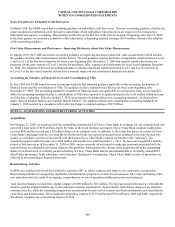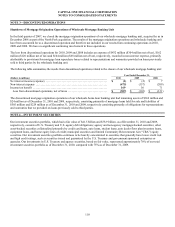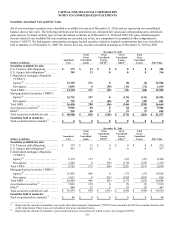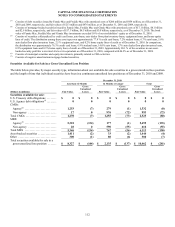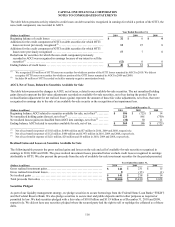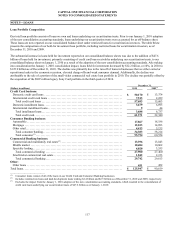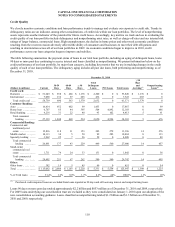Capital One 2010 Annual Report Download - page 129
Download and view the complete annual report
Please find page 129 of the 2010 Capital One annual report below. You can navigate through the pages in the report by either clicking on the pages listed below, or by using the keyword search tool below to find specific information within the annual report.
CAPITAL ONE FINANCIAL CORPORATION
NOTES TO CONSOLIDATED STATEMENTS
109
Scope Exception for Embedded Credit Derivatives
In March 2010, the FASB issued new accounting guidance on embedded credit derivatives. This new accounting guidance clarifies the
scope exception for embedded credit derivatives and defines which embedded credit derivatives are required to be evaluated for
bifurcation and separate accounting. The guidance is effective on the first day of the first fiscal quarter beginning after June 15, 2010.
In the third quarter, we recorded a cumulative effect adjustment to beginning retained earnings of $16 million, related to the adoption
of this accounting guidance.
Fair Value Measurements and Disclosures—Improving Disclosures about Fair Value Measurements
In January 2010, the FASB issued new accounting guidance on improving disclosures about fair value measurements which amends
the guidance for fair value measurements and disclosures. The new guidance requires disclosure of significant transfers between Level
1 and Level 2 of the fair value hierarchy for fiscal years beginning after December 15, 2009 and requires separate disclosures be
presented for the gross amount of Level 3 activity for purchases, sales, issuances and settlements for fiscal years beginning December
15, 2010. The adoption of this new accounting guidance to disclose significant transfers between Level 1 and Level 2 and activity
in Level 3 of the fair value hierarchy did not have a material impact on our consolidated financial statements.
Accounting for Transfers of Financial Assets and Consolidation of VIEs
In June 2009, the FASB issued two new accounting standards that amended guidance applicable to the accounting for transfers of
financial assets and the consolidation of VIEs. The guidance in these standards was effective for fiscal years beginning after
November 15, 2009. The accounting standard for transfers of financial assets was applicable on a prospective basis to new transfers,
while the accounting standard relating to consolidation of VIEs was required to be applied prospectively to all entities within its scope
as of the date of adoption. Effective January 1, 2010, we prospectively adopted these new accounting standards. As shown above
under “Special Purpose Entities and Variable Interest Entities,” the adoption of these new consolidation accounting standards on
January 1, 2010 resulted in a cumulative effect after-tax charge to retained earnings of $2.9 billion.
NOTE 2—ACQUISITIONS AND RESTRUCTURING ACTIVITIES
Acquisitions
On February 27, 2009, we acquired all of the outstanding common stock of Chevy Chase Bank in exchange for our common stock and
cash with a total value of $476 million. Under the terms of the stock purchase agreement, Chevy Chase Bank common stockholders
received $445 million in cash and 2.56 million shares of our common stock. In addition, to the extent that losses on certain of Chevy
Chase Bank’s mortgage loans are less than the level reflected in the net expected principal losses estimated at the time the deal was
signed, we will share a portion of the benefit with the former Chevy Chase Bank common stockholders (the “earn-out”). The
maximum payment under the earn-out is $300 million and would occur after December 31, 2013. We have not recognized a liability
related to this earn-out as of December 31, 2010 or 2009, and we currently do not expect to make any payments associated with the
earn-out based on estimated credit losses related to this portfolio. Subsequent to the closing of the acquisition all of the outstanding
shares of preferred stock of a wholly-owned subsidiary of Chevy Chase Bank and the subordinated debt of its wholly-owned REIT
(Real Estate Investment Trust) subsidiary, were redeemed. Subsequent to acquisition, Chevy Chase Bank’s results of operations are
reflected in our consolidated financial statements.
Restructuring Activities
In 2009, we completed the broad-based initiative started in 2007 to reduce expenses and improve our competitive cost position.
Restructuring initiatives leveraged the capabilities of infrastructure projects in several of our businesses. The scope and timing of the
cost reductions were the result of an ongoing, comprehensive review of operations within and across our businesses.
Total incurred charges exceeded the original estimate of $300 million by $63 million. The increase occurred because we extended the
initiative past the original timeline due to the continued economic deterioration. Approximately half of these charges were related to
severance benefits, while the remaining charges were associated with items such as contract and lease terminations and consolidation
of facilities and infrastructure. We recognized restructuring expense of $119 million and $134 million in 2009 and 2008, respectively.
We did not recognize any restructuring expense in 2010.





